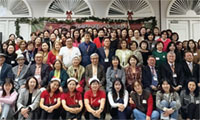Mangalitsa, a huge woolly pig from Hungary only recently back from near-extinction, is beginning to enjoy a vogue with purveyors and connoisseurs of pork.
The chef Paul Liebrandt has been offering a fragrant Mangalitsa strip loin at the refined Corton in Manhattan. “The flavor is intense, well rounded, balanced,” Mr. Liebrandt said. “It is wonderfully smoky.”
Mangalitsa, with its unctuous, intense flavor, is also becoming available to ordinary pig worshipers . D’Artagnan, the foie-gras purveyor, sells Mangalitsa ham cured in Spain at Grace’s Marketplace in Manhattan and other high-end outlets. DeBragga and Spitler, the specialty meat distributor in Manhattan, sells fresh retail cuts of Mangalitsa pork, as well as lard and hams, nationally on its Web site.
To produce their fabulous fat, Mangalitsas are raised for more than a year and can weigh more than 136 kilograms . Industrially bred pigs are slaughtered after no more than six months, at around 80 kilograms. In the United States, only some 50 Mangalitsas are processed each week - in comparison with more than 2 million pigs a week for all breeds, according to the National Pork Producers Council.
And Mangalitsas’ rolls of fat make them unsuitable for butchery in the American fashion, with a band saw producing a cross-section of pork cuts. Mangalitsas benefit from more laborintensive (read expensive) European butchery, where a carcass is broken down by its seams of muscle.
So Mangalitsa is pricey. In the New York area, a restaurant’s cost for a kilogram of boneless loin might be about $6 for the cheapest industrial hybrids, $15 to nearly $18 for Berkshire pigs, and $22 to $26 for Mangalitsa.
A growing number of small-scale hog farmers around the United States have found Mangalitsas easy to raise. “Mangalitsas are very hardy, with their woolly coats,” said Michael Clampffer, who has 120 of them at his Mosefund Farm in Branchville, New Jersey, selling their pork to restaurants and offering chops, sausage, bacon and lard on Sundays at the New Amsterdam Market in Manhattan.
Dr. Erno Hollo, 52, of the Basking Ridge Animal Hospital in New Jersey, has raised Mangalitsas on two hectares at his home and says they have few veterinary needs. Dr. Hollo, who emigrated from Hungary 26 years ago, grew up with hogs.
“I used to tend to farmers’ animals, and I took payment in Mangalitsa belly,” he said. “In Hungary, Boy Scouts didn’t make S’mores. They would take a slab of Mangalitsa, put the fat over the fire and drink the sweet fat as it melted.”
Mangalitsas, which have charcoal black coats, tan underbellies and twisty woolly tails, were historically raised for lard and prized for their mellow, silky fat. The former New York Times restaurant critic Ruth Reichl called it “the single best pastry fat I’ve ever found.” Their popularity declined with the substitution of cheaper vegetable oils for lard. Purebred Mangalitsas nearly vanished until a Hungarian geneticist worked to revive the breed several years ago.
Heath Putnam, in Auburn, Washington, was the first farmer to import Mangalitsa breeding stock and now has the largest herd outside of Europe, some 2,000. Of the 29 pigs he brought over, 4 were killed because tests showed they might have had bovine tuberculosis.
Mr. Putnam has spent $600,000 so far on his Mangalitsas. “For the last several months we’ve made a profit,” he said .
Johnston County Hams in Smithfield, North Carolina, has been curing Mangalitsa hams and shoulders for the last year.
Fans of the ham claim that it rivals the renowned Iberico of Spain and is superior to the more commonplace jamon serrano. But Jose Andres, the Spanish chef who owns seven restaurants in Washington, D.C., and Los Angeles, disagreed.
“Mangalitsa is a good product,” he said. “It’s O.K., it might equal a serrano, but definitely never an Iberico.”
George Faison, a partner and the chief operating officer of DeBragga, which sells the Mangalitsa ham and fresh pork, has been campaigning for the breed. “We hope it can come to occupy a small, but significant and profitable niche,” he said.
He helped organize a recent $85-aperson Mangalitsa tasting dinner. On the menu were jowls with American caviar, braised cheeks with pimento, endive and praline, and roasted neck roll with stuffed lady apple and organic rice polenta.
This sort of promotion has helped DeBragga become America’s largest Mangalitsa distributor.
“But that is to say, the biggest fish in a minuscule pond,” Mr. Faison said.
By GLENN COLLINS
스마터리빙
more [ 건강]
[ 건강]이제 혈관 건강도 챙기자!
[현대해운]우리 눈에 보이지 않기 때문에 혈관 건강을 챙기는 것은 결코 쉽지 않은데요. 여러분은 혈관 건강을 유지하기 위해 어떤 노력을 하시나요?
 [ 건강]
[ 건강]내 몸이 건강해지는 과일궁합
 [ 라이프]
[ 라이프]벌레야 물럿거라! 천연 해충제 만들기
 [ 건강]
[ 건강]혈압 낮추는데 좋은 식품
[현대해운]혈관 건강은 주로 노화가 진행되면서 지켜야 할 문제라고 인식되어 왔습니다. 최근 생활 패턴과 식생활의 변화로 혈관의 노화 진행이 빨라지고
사람·사람들
more많이 본 기사
- 마약딛고 함께 영화도 만들었는데…라이너감독 살해한 아들 체포
- 브라운대 총격사건 수사 난항 겪나…체포한 용의자 석방
- 트럼프, 라이너감독 피살에 “나에 대한 발작적 집착이 분노유발”
- ‘베네수 코앞’ 트리니다드토바고 “미군에 공항접근 허용”
- “연준의장 유력후보 해싯, ‘트럼프와 너무 가깝다’ 반대론 직면”
- “내 한국인 남편, 40일 넘게 개처… 1
- ‘15년째 활동 無’ 원빈 근황, 이시언 유튜브서 공개..”잘 지내는 중”
- 미·우크라 이틀간 종전협상…안전보장 진전, 영토 문제 난항
- 상무, 고려아연의 美제련소 건설 투자… 1
- 박나래 ‘링거·주사 이모’ 난리통 속 결국..MBC ‘팜유트립’ 제작 무산
- 美 지한파 중진 “한국 등과 다변화된 광물 공급망 구축해야”
- 국과수 “김수현·故 김새론 녹취파일, AI 조작 판정 불가”
- 현대車사장, ‘구금사태’ 조지아서 “일자리 4만개 창출할것”
- 180일 수사 마치고 재판 넘긴 내란특검…이제 ‘법원의 시간’
- 美당국자 “러, 우크라 EU가입에 열… 1
- ‘해리가 샐리를 만났을 때’ 롭 라이너 감독 부부 피살
- ‘128개 홈디포 매장서 319건 절도’ 플러싱 기반 전문절도단 일망타진
- NYT “美 SEC, 트럼프 재집권 후 암호화폐 소송 중단”
- 전재수, 통일교 행사 참석 의혹에 “고향서 벌초했다” 반박
- 美 “대외원조 중단한 적 없어…국가안보전략 원칙 맞춰 지속”
- 러 “우크라 나토 비가입, 평화 대화의 초석될 것”
- 野 “30년前 폭행 검증해야”…정원오… 1
- 원지, ‘6평 사무실’ 논란 후 첫 방송 출연..無편집 “적응 안 돼”
- 경찰, 쿠팡 6차 압수수색 11시간30분만에 종료 “데이터 방대”
- 항공기 승객정보 활용 추방 확대
- 역시 호날두! 북중미 WC 인기 티켓 1위는? 포르투갈-콜롬비아전... 3위가 한국-멕시코전 “개최국 효과”
- 워싱턴 한국학교협의회, 제37회 교사의 밤
- 뉴욕 백화점서 아기 기저귀 갈던 엄마, 정신질환자에 흉기피습
- ‘지독한 플래툰’ 김혜성도 71G 뛰었는데, 美 팬그래프 ‘송성문 ML 36G 타율 0.251’ 예상
- 비극 속 시민의 용기 총격범 맨손 제압
- [경제 트렌드] 외식비 줄이는 소비자… ‘팁 공포’ 한몫
- 백화점서 아기 기저귀 갈던 엄마 40대 정신질환자에 흉기 피습
- 테슬라 11월 미국 판매… 4년만에 최저
- 오늘의 베네수엘라가 내일의 동아시아국… 2
- 통계로 본 올해 대한항공… ‘캡틴 아메리카’ 가장 많이 보고, 최다 방문지 도쿄
- 서폭카운티 우정국 직원 우편물 절도 혐의 체포
- 안수화 회장 연임 확정
- 지구촌 또 ‘총기 난사’… 미·호주 잇단 참사
- 피로 얼룩진 주말…지구촌 곳곳 총격사건 잇달아
- 마약딛고 함께 영화도 만들었는데…라이너감독 살해한 아들 체포
- “성과는 있었지만 아직 끝 아냐” 2
- ‘내포 신도시 뉴욕설명회’성황
- ‘박성광♥’ 이솔이, 암 투병 중 안타까운 소식 “병원 몇 번 가는 건지..내 탓”
- ‘마리화나 규제 대폭 완화’ 트럼프, 행정명령 검토
- 워싱턴 지역 올 겨울 두 번째 눈
- 버지니아, 도로 상태‘전국 2위’…MD 13위·1위 GA
- 뉴욕·뉴저지 등 19개 주정부 H-1B비자‘10만달러 수수료’소송
- 오늘 추첨 파워볼 잭팟 11억달러로 ‘껑충’
- 시드니 유대인 총기참사 용의자는 50세 아버지·24세 아들
- ‘민권센터와 함께 따뜻한 겨울나기’
1/5지식톡

-
 테슬라 자동차 시트커버 장착
0
테슬라 자동차 시트커버 장착
0테슬라 시트커버, 사놓고 아직 못 씌우셨죠?장착이 생각보다 쉽지 않습니다.20년 경력 전문가에게 맡기세요 — 깔끔하고 딱 맞게 장착해드립니다!장착비용:앞좌석: $40뒷좌석: $60앞·뒷좌석 …
-
 식당용 부탄가스
0
식당용 부탄가스
0식당용 부탄가스 홀세일 합니다 로스앤젤레스 다운타운 픽업 가능 안녕 하세요?강아지 & 고양이 모든 애완동물 / 반려동물 식품 & 모든 애완동물/반려동물 관련 제품들 전문적으로 홀세일/취급하는 회사 입니다 100% …
-
 ACSL 국제 컴퓨터 과학 대회, …
0
ACSL 국제 컴퓨터 과학 대회, …
0웹사이트 : www.eduspot.co.kr 카카오톡 상담하기 : https://pf.kakao.com/_BEQWxb블로그 : https://blog.naver.com/eduspotmain안녕하세요, 에듀스팟입니다…
-
 바디프렌드 안마의자 창고 리퍼브 세…
0
바디프렌드 안마의자 창고 리퍼브 세…
0거의 새제품급 리퍼브 안마의자 대방출 한다고 합니다!8월 23일(토)…24일(일) 단 이틀!특가 판매가Famille: $500 ~ $1,000Falcon: $1,500 ~ $2,500픽업 & 배송직접 픽업 가능LA…
-
 바디프렌드 안마의자 창고 리퍼브 세…
0
바디프렌드 안마의자 창고 리퍼브 세…
0거의 새제품급 리퍼브 안마의자 대방출 한다고 합니다!8월 23일(토)…24일(일) 단 이틀!특가 판매가Famille: $500 ~ $1,000Falcon: $1,500 ~ $2,500픽업 & 배송직접 픽업 가능LA…
케이타운 1번가
오피니언
 옥세철 논설위원
옥세철 논설위원오늘의 베네수엘라가 내일의 동아시아국가…

퇴조의 핑크 타이드
 조지 F·윌 워싱턴포스트 칼럼니스트
조지 F·윌 워싱턴포스트 칼럼니스트 [조지 F. 윌 칼럼] 대통령의 전쟁수행권
 조옥규 수필가
조옥규 수필가 투고(To Go) 해야 하나?
 신경립 / 서울경제
신경립 / 서울경제 [만화경] ‘뒷마당’ 찾겠다는 트럼프식 먼로주의

22기 LA평통 출범에 거는 기대

연말 시즌 사기·범죄 경계해야
 메건 매카들 워싱턴포스트 칼럼니스트
메건 매카들 워싱턴포스트 칼럼니스트 [메건 매카들 칼럼] 장편영화의 마지막 챕터인가
 김미선 서북미문인협회 회장시인
김미선 서북미문인협회 회장시인 [한국춘추] 하늘을 계산한 사람들, 칠정산
1/3지사별 뉴스

피로 얼룩진 주말…지구촌 곳곳 총격사건 잇달아
지난 주말 동안 미동부 아이비리그 브라운대학에서 총격 사건이 발생, 최소 2명이 사망하고 9명이 부상한데 이어 호주 시드니에서는 사망자 16…
뉴욕·뉴저지 등 19개 주정부 H-1B비자‘10만달러 수수료’소송

워싱턴 한국학교협의회, 제37회 교사의 밤
재미한국학교 워싱턴지역협의회(회장 정광미)가 13일 ‘제 37회 교사의 밤’을 개최, 한 해 동안 헌신한 교사들의 노고를 위로했다. 올해 최우…
안수화 회장 연임 확정

마약딛고 함께 영화도 만들었는데…라이너감독 살해한 아들 체포
할리우드 명감독 롭 라이너 부부를 살해한 혐의로 체포된 아들 닉 라이너(32)는 10대 시절 마약 중독으로 재활센터와 노숙 생활을 전전한 이력…
내년 중간선거 낙관못하는 트럼프… “경제성과 전달에 시간 걸려”

오늘 하루 이 창 열지 않음 닫기 





















































.png)


댓글 안에 당신의 성숙함도 담아 주세요.
'오늘의 한마디'는 기사에 대하여 자신의 생각을 말하고 남의 생각을 들으며 서로 다양한 의견을 나누는 공간입니다. 그러나 간혹 불건전한 내용을 올리시는 분들이 계셔서 건전한 인터넷문화 정착을 위해 아래와 같은 운영원칙을 적용합니다.
자체 모니터링을 통해 아래에 해당하는 내용이 포함된 댓글이 발견되면 예고없이 삭제 조치를 하겠습니다.
불건전한 댓글을 올리거나, 이름에 비속어 및 상대방의 불쾌감을 주는 단어를 사용, 유명인 또는 특정 일반인을 사칭하는 경우 이용에 대한 차단 제재를 받을 수 있습니다. 차단될 경우, 일주일간 댓글을 달수 없게 됩니다.
명예훼손, 개인정보 유출, 욕설 등 법률에 위반되는 댓글은 관계 법령에 의거 민형사상 처벌을 받을 수 있으니 이용에 주의를 부탁드립니다.
Close
x